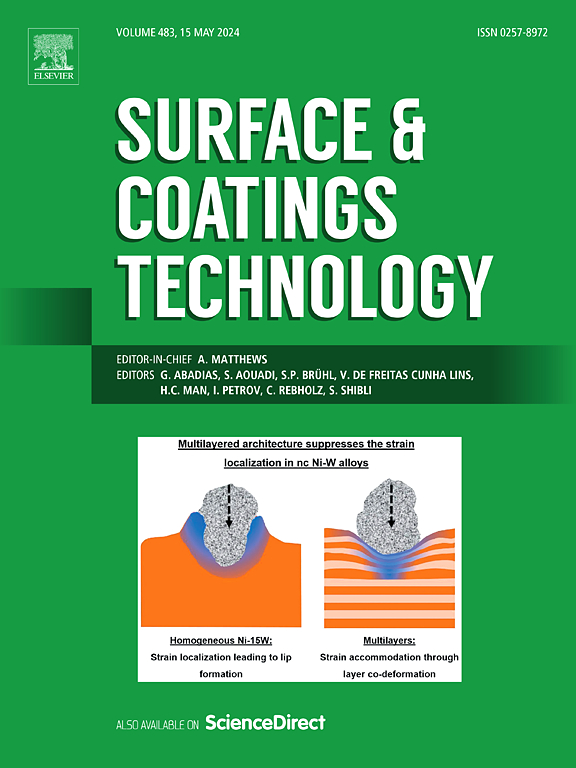Oxidation and failure mechanisms of CoCrFeNiMo HEA coatings at 1000 °C: Insights into TGO evolution and interface diffusion
IF 6.1
2区 材料科学
Q1 MATERIALS SCIENCE, COATINGS & FILMS
引用次数: 0
Abstract
This study investigates the oxidation behavior and failure mechanisms of CoCrFeNiMo high-entropy alloy (HEA) coatings fabricated via high-velocity oxygen fuel (HVOF) spraying and high-frequency induction remelting. At 1000 °C, the thermally grown oxide (TGO) developed a dual-layer structure: a dense Cr2O3 inner layer, formed by Cr3+ and O2− diffusion, and an outer layer of Cr-, Fe-, and Mo-rich composite oxides driven by oxygen ion diffusion. After 5 h of exposure, the TGO reached 30 μm with initial crack formation, while after 200 h, it exceeded 50 μm, showing severe outer-layer degradation due to internal stress, crack propagation, and void formation. Fe/Mo interdiffusion at the coating-steel substrate interface promoted Fe63Mo37 R-phase formation. Electron backscatter diffraction (EBSD) analysis revealed refined grains, twinning, and recrystallization within the coating, enhancing high-temperature stability. These findings offer insights into the oxidation and failure mechanisms of CoCrFeNiMo HEA coatings, supporting their optimization for extreme high-temperature applications.
CoCrFeNiMo HEA涂层在1000℃下的氧化和失效机制:对TGO演化和界面扩散的见解
研究了高速氧燃料(HVOF)喷涂和高频感应重熔制备CoCrFeNiMo高熵合金(HEA)涂层的氧化行为和失效机理。在1000℃时,热生长氧化物(TGO)形成了双层结构:由Cr3+和O2−扩散形成的致密Cr2O3内层,以及由氧离子扩散驱动的富含Cr-、Fe-和mo的复合氧化物外层。暴露5h后,TGO达到30 μm,开始形成裂纹,200 h后,TGO超过50 μm,由于内应力、裂纹扩展和空洞形成,外层出现严重退化。Fe/Mo在涂层-钢基体界面处的相互扩散促进了Fe63Mo37 r相的形成。电子背散射衍射(EBSD)分析显示,涂层内部有细化晶粒、孪晶和再结晶,增强了高温稳定性。这些发现为CoCrFeNiMo HEA涂层的氧化和失效机制提供了深入的见解,为其在极端高温应用中的优化提供了支持。
本文章由计算机程序翻译,如有差异,请以英文原文为准。
求助全文
约1分钟内获得全文
求助全文
来源期刊

Surface & Coatings Technology
工程技术-材料科学:膜
CiteScore
10.00
自引率
11.10%
发文量
921
审稿时长
19 days
期刊介绍:
Surface and Coatings Technology is an international archival journal publishing scientific papers on significant developments in surface and interface engineering to modify and improve the surface properties of materials for protection in demanding contact conditions or aggressive environments, or for enhanced functional performance. Contributions range from original scientific articles concerned with fundamental and applied aspects of research or direct applications of metallic, inorganic, organic and composite coatings, to invited reviews of current technology in specific areas. Papers submitted to this journal are expected to be in line with the following aspects in processes, and properties/performance:
A. Processes: Physical and chemical vapour deposition techniques, thermal and plasma spraying, surface modification by directed energy techniques such as ion, electron and laser beams, thermo-chemical treatment, wet chemical and electrochemical processes such as plating, sol-gel coating, anodization, plasma electrolytic oxidation, etc., but excluding painting.
B. Properties/performance: friction performance, wear resistance (e.g., abrasion, erosion, fretting, etc), corrosion and oxidation resistance, thermal protection, diffusion resistance, hydrophilicity/hydrophobicity, and properties relevant to smart materials behaviour and enhanced multifunctional performance for environmental, energy and medical applications, but excluding device aspects.
 求助内容:
求助内容: 应助结果提醒方式:
应助结果提醒方式:


